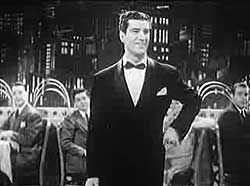 A pleasant crooner with the unlikely name of Harry Cool (which couldn't've helped his career as much as he hoped it would) sings Hoagy Carmichael's best known song in the three-minute soundie Stardust (1945).
A pleasant crooner with the unlikely name of Harry Cool (which couldn't've helped his career as much as he hoped it would) sings Hoagy Carmichael's best known song in the three-minute soundie Stardust (1945).
Harry had earlier in the decade sung with the Dick Jurgens Orchestra. But by 1945 he had his own band, billed as Harry Cool & His Orchestra.
This poor guy should've stuck to radio & sound recordings as standing in front of a camera, he seems scared to death & poses like a department store maniken, his big square head looking like he's carved out of wood. But he's got a nice voice for this classic tune.
When it reaches the instrumental, the June Taylor Dancers come out in beautiful evening gowns & dance to a muted trumpet solo. Harry returns to stand amidst the gals to finish the song.
This soundie was combined with two others for release to the home-movies market as a one-reeler called Songs of Romance (1945). The other two components were by the gypsy-inspired violin-based Emery Deutsch & His Orchestra, namely Two Guitars/Dark Eyes (1941) & Love's Own Sweet Song (1941).
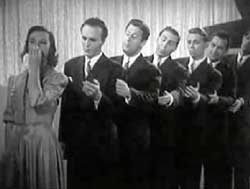 I don't like the cleaned up preppy sound of the singers in Sweet Sue (1941; sometimes given as 1945 but that's when it was registered for copyright rather than released, due only to slipshod paperwork not getting it registered in a timely manner). They're the Six Hits & a Miss, but for me they were all seven a miss. I don't like the cleaned up preppy sound of the singers in Sweet Sue (1941; sometimes given as 1945 but that's when it was registered for copyright rather than released, due only to slipshod paperwork not getting it registered in a timely manner). They're the Six Hits & a Miss, but for me they were all seven a miss.
Yet the all-girl band backing them up are great. They're the Lorraine Paige Orchestra, & they're vastly better than the singers. The orchestra made five soundies all told, all around the same time.
The Six Hits together with six young women start dancing around the Miss. Their dancing gives them more appeal than when they are just standing still harmonizing. Their singing definitely drags down the band's performance.
The song "Sweet Sue, It's You" is by Will Harris & Victor Young, & it just might not be a good enough tune to show the singing group's better abilities, but I suspect they couldn't ever come off as anything but milquetoast.
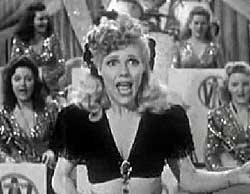 Thelma White & Her Orchestra are great in Hollywood Boogie (1946).
Thelma White & Her Orchestra are great in Hollywood Boogie (1946).
Good-lookin' Nebraskan Thelma had a cult following in her day, having starred in the exploitation classic Reefer Madness (1936).
In Hollywood Boogie which has nothing to do with Hollywood, she conducts her all girl band & manages to do a nice little boogie woogie dance at the same time. She then bursts into song with the girls in the band doing back-up vocals.
This was a superb band for the time, & Thelma was just the sort of entertainer for the soundie jukeboxes, when sailors & soldiers were the major customers eager to boogie & at the same time see pictures of pretty girls with their song selection.
Thelma went on tour to entertain the troops, but nearly ended her career when she came down with a never-diagnosed illness while performing on a base in the Aleutians. She was bedridden for at least four years, off & on after that, having been informed by doctors she would never recover.
She did partially recover & made minor film appearances when she could. In the three soundies she made in 1946, you would never be able to tell she was still suffering rheumatoid pain, & would have to retire from performing two years later. She kept her hand in show business as an actors' manager, her stable including Debbie Reynolds, James Coburn, & the now-notorious Robert Blake.
She puts on such an exciting show in under three minutes with Hollywood Boogie. She even does some actual screaming which would not be unusual in the rock 'n' role era but was great & original in 1946, especially for a woman singer. The song is "Shoo Shoo Ya Mama" though when first recorded by Lionel Hampton it was called "Hamp's Boogie Woogie."
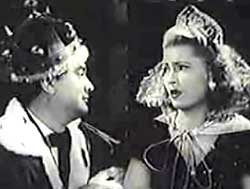 A nice little jazz tune lends its title to The Rotary Swing (1943). Carol Parker steps out immediately from behind a curtain & begins the song, with a shift to another set soonafter, where she sings next to the band leader.
A nice little jazz tune lends its title to The Rotary Swing (1943). Carol Parker steps out immediately from behind a curtain & begins the song, with a shift to another set soonafter, where she sings next to the band leader.
The band leader's in a king's cape & crown, she in a queen's. It's Ivan Scott & His Orchestra, with Ivan hamming it up as much as he can in order to get at least a little of the attention. Superimposed on the image of the king & queen are the legs of dancers being somewhat instructional on how to do the rotary swing.
We're next treated to a man & a woman twirling round very prettily in each others arms, superb dancers. At the point of the instrumental, another dance couple is seen, doing the boogy woogy. Busying up its under-three-minutes still further, we see a choaras line.
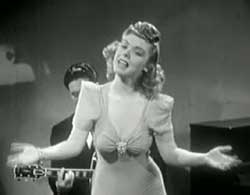 The song for the soundie Who's Yehoodi (1943), written by Bill Seckler & Matt Dennis, is a novelty number, with successful funny-macabre lyrics about "the little man who wasn't there."
The song for the soundie Who's Yehoodi (1943), written by Bill Seckler & Matt Dennis, is a novelty number, with successful funny-macabre lyrics about "the little man who wasn't there."
At the same time, it's as much a cool piece of jumpin' jive as it is a comedy celebrating the catch-phrase of comic Jerry Colona, for a running gag that got started with an incident on Bob Hope's radio show involving violinist Yehudi Menhuin.
Colona's routine involved a quest for a mystic figure he could never find. It became such a common recurring routine that parents began saying "Yehudi did it" whenever their children gave them kids' universal mistruth, "I didn't do it!" During World War II, the Yehudi Project to campaflauge ships & airplanes was named for Calona's routine.
The singer is Lane Truesdale, & she does a great job, a bit reminiscent of Rosemary Clooney.
Truesdale is backed up by an excellent but uncredited three-musician combo consisting of piano, slap base, & guitar. Someone on Weirdo Video claimed they were members of Kay Kyser's Music College though this isn't so, even though Kay Kyser did record a version.
Hanging on the wall behind Lane is a portrait of Yehoodi, a big-bearded Jew, a fairly awful racial stereotype. As with the misidentification of Kay Kyser having something to do with the combo, the unidentified guy playing the portrait was claimed to be Jerry Cologna himself, but not even close.
When Lane is wiggling her hips, Yehoodi's portrait turns its head & watches her fanny, of which we get a close-up too. As the song ends, the portrait yells out, "I'm Yehoodi!" & lowers a blind.
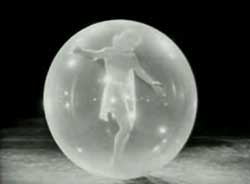 Who's Yehoodi was also distributed as part of a one-reel home-movie with two other soundies under the collective title Music with Spice No. 5 (1947).
Who's Yehoodi was also distributed as part of a one-reel home-movie with two other soundies under the collective title Music with Spice No. 5 (1947).
The other two components were Ginger Harmon singing There'll Be Some Changes Made (1942) & artful burlesque of Sally Rand in The Artist's Model (1942).
In There'll Be Some Changes Made, Harmon sings with back-up from George Steiner & His Orchestra. In The Artist's Model Sally Rand is dancing & taking classical poses to a piece of classical music by Lud Gluskin & His Orchestra.
Official Films released all three of Sally Rand's films in home movies, including a silent version of all three together on one reel as Bubbles & Fans (1942), doing away with the classical music.
Although famed as a fan-dancer, her coolest soundie is The Bubble Dance (1942). In a short gossamer costume, looking as close to naked as was legal, the performance opens to classy slow music. Sally appears to actually be inside an enormous perfectly round balloon.
But she's behind it, not in it, & momentarily begins to manipulate & toss the nearly weightless & transluscent ball while moving in slow motion with classical grace.
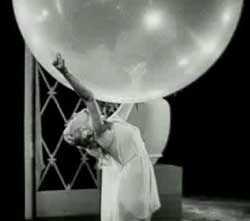 It's a mesmerizing performance, poetic rather than seedy, with a few simple camera tricks, such as the reversed footage when Sally lays back on the floor in a willing posture, & the balloon floats upon her like a lover. It's a mesmerizing performance, poetic rather than seedy, with a few simple camera tricks, such as the reversed footage when Sally lays back on the floor in a willing posture, & the balloon floats upon her like a lover.
When she kicks the balloon off her, it's no accident that she has created the illusion of wearing no panties, as her act wants it both ways, as tasteful as ballet, as heated as a nudie show. The performance ends with back-lighting to reveal Sally's body within the gossamer.
This is just an awfully clever throwback to the roots of American cinema, when numerous such films like Anabelle Butterfly Dances (1894) were viewed in peep-show mutoscopes.
Besides becoming part of Bubbles & Fans, this one was also included on the Official Films one-reeler Music & Spice Number 3 (1947). The other two parts were I Wanna Make Him Whistle (1943) featuring "Isabelita," & I've Got to Get Hot (1942) featuring Gracie Barrie.
The first-name-only Isabelita would later have a minor film career as Lita Brown. Here she plays a Latina with slutty disposition tempting passersby, until she gets a little surprise to her fanny.
Gracie Barrie's performance is set in a burlesque house with what appear to be underaged choras girls. All her soundies were artfully seedy; in days when the FBI would literally bash in the office doors or porno distributors & steal all their stocks, companies like Official Films & Castle Films could get away with interstate trafficing of home-movies that weren't quite actionable, & Gracie played straight into that potential.
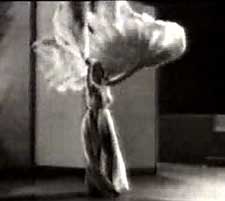 Sally Rand's remaining soundie with classical music by the Lud Guskin Orchestra was The Fan Dance (1942), her most famous innovation. Sally Rand's remaining soundie with classical music by the Lud Guskin Orchestra was The Fan Dance (1942), her most famous innovation.
She was said to have invented the often-copied fan dance at a gig where her costumes didn't show up in time to be worn on stage. Of course, the reason such enormous fans were available in a pinch was because the fan dance already existed, but sometimes legends are nice.
She starts out wearing a floor-length gossamer gown which can just about be seen through. Soon she steps behind a screen where her silhouette is obviously naked.
When she steps out from behind the screen, a quick edit leaves the impression she's still naked, as she whirls about totally covered by the two enormous fans, daring the viewer to try to see something hidden. She was of course wearing a tight imperceptible body sock.
Proud of never having performed in a burlesque house, there's no denying Sally was a class act, but she shouldn't've looked down on her burlesque sisters just because she was able to hornify the world with larger venues & brighter lights & was provided with such polite titles as "the nightclub nudist."
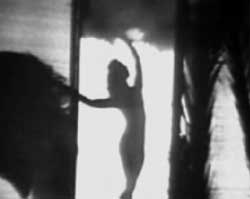 The Fan Dance was included on Music with Spice #2 (1947) together with two other performances. Commedienne Luba Malina in Minnie from Trinidad (1942) performs a comedy skit reliant on race stereotyping. The Fan Dance was included on Music with Spice #2 (1947) together with two other performances. Commedienne Luba Malina in Minnie from Trinidad (1942) performs a comedy skit reliant on race stereotyping.
Minnie from Trinidad, written by Roger Edens, was originally made famous by Judy Garland in Ziegfield Girl (1941). The music for the soundie is provided by Frank Denning & His Orchestra.
Last of all is The Biggest Aspidastra in the World (1942) featuring Johnny Messner & His Orchestra. The same unnamed girl from Johnny's soundie Are You Happy? Amen! (1942) is seen clad in a bonnet & country dress discussing the size of an aspidastra plant.
The camera pulls back & Johnny is standing to this young woman's right (viewer's left) wearing bib overalls & holding a rake. He begins singing about how big the aspidastra grew, while chorus girls water plants by bending over with their butts to the camera, revealing their undies.
Johnny, having a bit of a reputation for singing mildly amusing double-entandre songs, keeps stressing the "ass" in the world's biggest aspidastra while making their way to the concluding verse:
"The dogs all come around for miles, a lovely sight to see/ They sniff around for hours & hours & wag their tails with glee / So I've had to put a notice up to say it's not a tree/ It's the biggest aspidistra in the world..."
There are other bits about ass-pidastras involving a jump-cut to a bar where Johnny's fat-assed father boasts about having the biggest aspidastra, & a bit where stuffed animal terriers (similar to a batch of pull-toy dogs seen in There's Something About a Soldier, 1951) are attracted to the big aspidastra.
The aspidastra song is lyrically so dumb that it's hard to judge if the instrumental is any good. At the conclusion, Johnny shows us a potted aspidastra.
The two comedies that fill out Music with Spice #2 are odd matches to go with Sally's artful erotic dancing, but maybe someone at Official Films thought that if some husband got caught watching Sally alone, he could feign interest in the comedy bits, & not his fault if Sally Rand is on the same much-viewed reel.
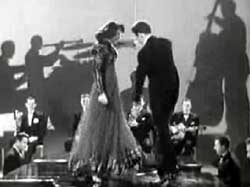 Homely Gai Moran sings somewhat generic boogie-woogie in Zig Me Baby with a Gentle Zag (1941).
Homely Gai Moran sings somewhat generic boogie-woogie in Zig Me Baby with a Gentle Zag (1941).
Her body language is peculiar, as she's seen hunching her shoulders up & down as though she thinks she's dancing, while Danny Hocktor dances beside her, tossing his arms about like a articulated scarecrow in a tux.
The "stage" they're dancing upon is actually four pianos. There are two boogywoogie pianists on each side below the couple.
It's visually an interesting composition, but as a dance couple they seem awfully subdued, perhaps not so much from what looks like poor talent as the fact that they're very constrained by or frightened of falling from the tiny space.
The singing is so-so, the dancing is poor, but the clustered pianists are great. They're the Mills Piano Quartet, meaning they were stuido musicians hired by the Mills Panoram company. I suppose it's such a standard boogie beat that any studio musicians could've done it, but these guys certain seem especially good.
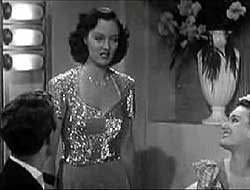 Sour-faced Joy Hodges in a silvery evening gown sings Row, Row, Row (1940) with a ragtime flavor. Although the lyrics are abysmal ("He would row, row row. Way up the river. He would row, row, row. A hug he'd give her") the jauntiness of the piece almost sells it.
Sour-faced Joy Hodges in a silvery evening gown sings Row, Row, Row (1940) with a ragtime flavor. Although the lyrics are abysmal ("He would row, row row. Way up the river. He would row, row, row. A hug he'd give her") the jauntiness of the piece almost sells it.
Joy has gone down in history as the woman who told Ronald Reagan to "ditch the glasses" which some credit with getting his film career off the ground since he'd been showing up at auditions looking like a four-eyed geek.
Her career lasted a long time with some impressive highlights, especially on Broadway, yet in her attempt to become a film star, she seemed always to be one of the also-rans just the short side of a real breakthrough.
An appearance in Follow the Fleet (1936) is about the height of her film success, but who'd ever remember her when they came to see Fred Astair & Ginger Rogers. Row, Row, Row pretty much reveals why her successes stopped at a dull point.
As the song progresses, Joy just gets worse & worse at it. Then she makes sex-noises while wiggling her shoulders as though rowing a boat -- or writhing in ecstacy. Soundies often tried to sneak in sexy bits & were widely criticized at the time for indecency, but this gal could shut down those jukebox-playing sailors with her flacidity-inducing act.
Watching her from one of the tables, without smiles or lecherous interest (realism in this case), are three disinterested well-dressed gents.
When the awful song is almost over, the gents whip off their jackets to reveal their college rowing team sweaters. They hastily put together a sort of a skate-board thingie pretending it's a boat, grab Joy to sit in front of them on the skateboard, & with miniature oars row off the stage.
An amusingly stupid finale, the rowteam gents are the Three Rio Brothers, namely Frank, Jim, & Larry. They had a song, dance, & comedy act of their own, but don't get to do squat in this soundie & their roles might just as well have been played by any tim dick & harry.
The unseen band for this terrible dreary piece was Rudolf Friml, Jr. & His Orchestra. It got recycled into Castle Films home movie Hit Parades Hits (1944) together with The White Cliffs of Dover (1941) & Anniversary Waltz (1942).
Anniversary Waltz featured Marc Plant & Helen Cole backed by Ted Fito Rio & His Skylined Music. The White Cliffs of Dover is sung by Sugar Kane in military outfit, assisted by Dick Hogan, backed by Stan Kenton & His Orchestra.
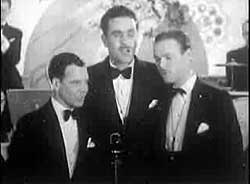 Billy Bissett & His Canadian Band perform in A Little Robin Told Me So (1936). The novelty tune was written by Benny Davis, J. Fred Coots & Bob Rothberg.
Billy Bissett & His Canadian Band perform in A Little Robin Told Me So (1936). The novelty tune was written by Benny Davis, J. Fred Coots & Bob Rothberg.
Because the three-minute length was perfect for Panoram Jukeboxes which required three-minute films, I wonder if this little film mightn't've been longer originally, & got recycled in the early 1940s at the needed length.
Billy's band performs without glitz or flash, but very well, & he's cute as a bug impersonating a human being in that oversized tux. It's not long before he walks to the microphone to introduce the Three Canadian Capers "who will bring the lyrics to you."
The singing trio is made up of bandmembers doing double duty at the microphone. They sound truly old-fashioned even for 1936, blending a little ragtime with the Victorian.
They finish the lyrics then rush back to their seats to pick up their instruments, as there aren't a great many guys in the band & they need everyone to sound like a Big Band.
copyright © by Paghat the Ratgirl
|
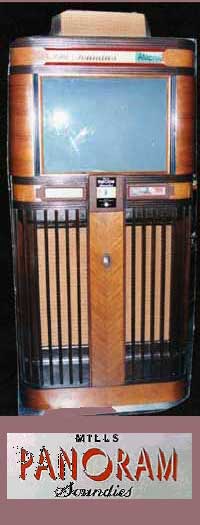






 It's a mesmerizing performance, poetic rather than seedy, with a few simple camera tricks, such as the reversed footage when Sally lays back on the floor in a willing posture, & the balloon floats upon her like a lover.
It's a mesmerizing performance, poetic rather than seedy, with a few simple camera tricks, such as the reversed footage when Sally lays back on the floor in a willing posture, & the balloon floats upon her like a lover.
 The Fan Dance was included on Music with Spice #2 (1947) together with two other performances. Commedienne Luba Malina in Minnie from Trinidad (1942) performs a comedy skit reliant on race stereotyping.
The Fan Dance was included on Music with Spice #2 (1947) together with two other performances. Commedienne Luba Malina in Minnie from Trinidad (1942) performs a comedy skit reliant on race stereotyping.

